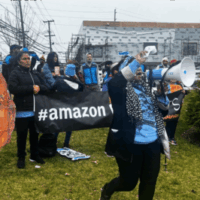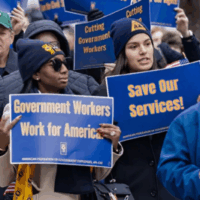Legislature Passes Bill that Raises Wages for Half a Million Workers
Washington, DC—Less than twenty-four hours after Governor Larry Hogan vetoed legislation to raise Maryland’s minimum wage to $15 by 2025, the Legislature overrode it with supermajorities in both chambers.
Maryland becomes the sixth state in the nation—and the first south of the Mason-Dixon line—to adopt a $15 minimum wage. The state follows closely after Illinois and New Jersey, which in February adopted plans to reach $15, in gradually raising its wages closer to what is widely considered the very minimum necessary for a worker to cover basic living costs. Proposals to preempt local governments from adopting higher wages levels were also defeated during the legislative session.
Maryland’s minimum wage has gradually increased to its current level of $10.10 from $7.25 since 2015.
The new law calls for gradually raising the state’s minimum wage to $15 by 2025 for most workers. Businesses with fewer than 15 employees will have until 2026 to reach $15. The law, however, leaves in place exemptions for certain agricultural workers and allows employers to pay a training wage to employees under the age of 20. The tipped minimum wage will remain frozen at $3.63 an hour, perpetuating the two-tiered wage system for service employees.
“Today, half a million Marylanders struggling to make ends meet took an important step forward, moving closer to making a decent living,” said Christine Owens, executive director of the National Employment Law Project. “The coalition that made this possible pulled together people from all walks of life who shared the fundamental belief that no one should have to work multiple jobs—spending countless hours away from loved ones—to just barely put food on the table and keep the lights on.”
Minimum wage workers not only are much more likely to experience poverty, but low wages also impact women and workers of color at higher rates. Analysis by the Economic Policy Institute of data from states with no tipped minimum wage, or One Fair Wage states, shows that service workers in these states earn more and suffer lower rates of poverty. In New Jersey, legislators rejected similar efforts by corporate lobbyists to leave young workers behind.
Raising the minimum wage also increases consumer spending and so can boost demand for goods and services, keeping money circulating in the economy and creating a virtuous cycle that benefits workers, businesses, and communities.
In recent weeks, Governor Hogan pulled no punches in opposing the minimum wage. At a press conference, he issued a counterproposal calling for a lower wage and regional differences that would lock less affluent parts of the state into poverty wages. His efforts were to no avail, though. The Legislature also rejected amendments to the law that would have limited local governments’ ability to set higher wages, as Montgomery and Prince George’s counties have. LOCAL Maryland, a coalition that brought together health, environmental, and labor groups like the NAACP and the American Heart Association, spoke out against attempts to block communities from enacting higher standards than those set statewide.
The increase comes on the heels of increased worker demands for fair pay and greater public investment, as workers feel increasingly squeezed at work and at home. Last year, a Federal Reserve Board report found that 40 percent of Americans didn’t have $400 to cover an unexpected expense. In the past two years alone, the U.S. has seen major labor actions by teachers, hotel, and airport workers, resulting in improved pay and working conditions for workforces that are crucial to the nation’s economy. The Maryland Center on Economic Policy estimates that 573,000 workers will directly benefit from the minimum wage increase.
“The victory in Maryland, which is on the heels of a major corporation’s decision to abandon its opposition to increased wages, underscores that $15 is the new mainstream consensus in the United States. Workers are facing the same spiraling costs of living everywhere and we’re seeing voters demand progressive leadership on economic and other issues. Customers want the people serving them in restaurants and taking care of their kids at daycares to also make a decent living. Unfortunately, the current bill still leaves young workers and tipped workers behind,” said Owens.
With Maryland joining the five other states on the path to $15, approximately 29 percent of the U.S. workforce will be covered by a $15 minimum wage by 2025. The move also adds momentum to the drive to raise the federal minimum wage. Raising the federal minimum wage to $15 would lift pay for a quarter of all workers in the United States, including those in the 21 states stuck at the current federal level of $7.25.
Since workers in New York first walked out of fast-food jobs in November 2012 to demand a $15 minimum wage and a union, more than 20 states and 40 cities and counties have raised their minimum wage, with raises amounting to more than $68 billion. Additional campaigns to raise the minimum wage are underway in more than 15 states, includingConnecticut, Vermont, Minnesota, and Hawaii, all of which are considering minimum wages of $15 or more per hour.
###
The National Employment Law Project is a non-partisan, not-for-profit organization that conducts research and advocates on issues affecting low-wage and unemployed workers. As a national intermediary and back-up resource for many minimum wage campaigns around the country, NELP was pleased to be able to support the work of the coalition that fought to raise the minimum wage in Maryland. For more information about NELP, visit www.nelp.org.
Related to
The Latest News
All newsMayor Bowser & D.C. Council Must Respect the Will of D.C. Voters by Rejecting Repeal of Initiative 82

Blog
New Brief Sheds Light on the Amazon’s Dangerous ‘Flex’ Labor Model

News Release
NELP Denounces Supreme Court Ruling Permitting Immediate Layoffs of Hundreds of Thousands of Federal Workers

News Release
